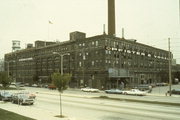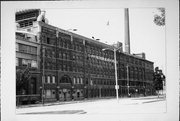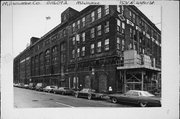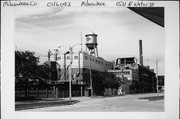| Additional Information: | ARCHITECTURAL DESCRIPTION: The Pfister & Vogel building is a long rectangular, five-story brick building, comprised of several separate sections constructed contiguously. Stylistically, these are fairly utilitarian industrial designs, whose primary design features are the repetive window groups and corbelled cornice. Articulation of the long southeast street elevation varies from unit to unit. Some portions are vertically divided by pilasters, while others are flat facades broken only by the window openings. Windows are both rectangular and segmental arch openings, some grouped in repetitive units and others evenly spaced. The various portions appear visually integrated, due to primarily to the use of brick and a consistent cornice height. (1982 photo - 35-33) ARCHITECTURAL SIGNIFICANCE: The building is architecturally significant because it is a good example of industrial construction, and "additive" architecture resulting from the growth and expansion of the business. It is also important as an example of tannery architecture. Construction date, 1876 through 1910. (A) HISTORICAL SIGNIFICANCE: The firm dates its organization from 1847, when Guido Pfister established the Buffalo Leather Store on Market Square in Milwaukee. At the same time, Frederick Vogel established a tannery on the Menominee River. In 1857, Pfister & Vogel merged their interests into one. Pfister & Vogel were both born in Wurtemburg, Germany, coming to America in 1845 and 1846, respectively (B). Both worked in the Buffalo, New York Tannery of J. F. Schoellkopf, a cousin of Vogel. Their new enterprise in Milwaukee was initially financed by Schoellkopf, who loaned Pfister & Vogel $12,000. By the late 1850's, the tannery had expanded its operations into other locations in Wisconsin, and then opened a plant in Michigan. Schoellkopf withdrew his financial interest when the company was on solid footing. By 1870 Pfister & Vogel was the biggest tanner west of the Alleghenies. About this time it acquired the Zohrlaut Leather Company, also established in Milwaukee in 1857. By World War I, Pfister & Vogel was the largest tanner in the world, with hides imported from Mexico, China, South America, India, Europe, Africa and Australia. By this time successors to the founders were operating the firm: Fred Vogel, Jr., president; Charles F. Pfister, (Owner of the Pfister Hotel), vice-president; August H. Vogel, vice-president; and Guido C. Vogel, general manager. World War I years were some of the firms most profitable, however, collapse of the commodities market and large inventory losses, combined with competition from cheaper foreign leather in the 1920's, forced the company to reorganize in 1931. The firm again prospered, adopting an employee's profit sharing plan in 1937, and a retirement plan in 1943 (C). Pfister & Vogel remains in operation today. Legal Descrip. Fractional west 1/2 of SW 1/2 section 21-7-2 2 or Gammon Float Block 123 all blk 123 & part lots 24 and 25 Block E Hathaway S Subdivision adj. lying S of Bi-way Easement & all blk 123 exc St & all vacant E. Lyon St. Adj. and lots 1-2-3 & NE 1/2 lot 4 exc St. In. Block 144) partition of SE fraction of Sec. No 20-7-22 adj. This block-long complex which occupies the east side of the Milwaukee River is comprised of no less than five major blocks known to have been erected between 1889 and 1916. Four, historic five-story blocks and a one-story office wing comprise the north half of the complex, while the southern half is a mixture of ca. 1930s-1950s additions. Despite the approximately twenty-five year span in construction of the north half, features that remain consistent include segmental arch window heads, a heavy brickwork cornice and a significant amount of original, four-light, double-hung sash windows. The five-story structures, although industrial vernacular in nature, are somewhat reminiscent of the German Renaissance Revival style. The one-story office wing, added in 1897, is Classical Revival in style; however, an additional two stories were added in the circa 1940s. The additions, which comprise the southern half of the complex are modern and are without any distinguishing features. The bulk of this complex was constructed by Herman Zohrlaut for his namesake company, the Herman Zohrlaut Leather Co. Zohrlaut began his tannery business in 1857, the same year that the well-known Pfister & Vogel tannery was established on the Menomonee River. An article printed in the Milwaukee Sentinel on 5 January 1865 notes that Zohrlaut had previously partnered with Adolph Neyman and erected a two-and-one-half story tannery structure in November 1864 which cost $15,000. By 1878, Zohrlaut was joined in business by Edward Zohrlaut and Henry Eskuche. Flower's 1881 History of Milwaukee indicates that the Zohrlaut tannery operation was one of the city's largest, employing 75 men. Although no building permits exist for the complex prior to 1889, permits thereafter indicate that a variety of additions were made to the complex between 1889 and 1910 and a variety of prominent architects were involved in those designs. In the 1890s, C.F. Ringer was responsible for at least four structures and Ferry & Clas designed at least two. In 1916, the leather-making facility was purchased by Pfister & Vogel. The new occupant employed architect F.J. Esser to perform a $15,000 remodeling. Pfister & Vogel, which later became known as Wisconsin Leather, closed its operations within the last year. As the previous paragraph indicates, the subject facility was designed by a variety of prominent Milwaukee architects. Despite that fact, the structures are largely vernacular in appearance and were designed more for their function than outward image. Historibase records indicate that this industrial complex is a good example of additive architecture. While the north half of the complex retains enough character and integrity to support that supposition, the southern portion is substantially modern in nature and, therefore, destroys its overall integrity. Secondly, historibase information also indicates that this complex is significant for its association with Pfister & Vogel. While the firm purchased this property in 1916 and occupied the complex for the last 84 years, it was not originally occupied/erected by their concern. In fact, the Pfister & Vogel main tannery building, located on the Menomonee River, is already listed on the National Register. |
|---|




